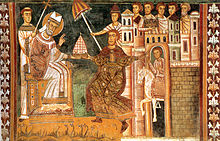 |
| Adoration of the Magi - Roman catacombs c3rd Source: Giovanni Dall'Orto, Wiki commons |
For most of the year, I don't have major problems with most of the calendar changes made in 1960 - if it was up to me (which it isn't!) there are some feasts I'd restore, but octaves aside, the changes to the calendar mostly were not too drastic (certainly not by comparison with those made in 1970, when whole seasons were excised).
But the period January 2 to January 13, is, I have to admit, something of a disaster zone liturgically.
Let's take a look at the key issues.
January 2 - 4
For centuries, January 2 - 4 were taken up by the Octave days of St Stephen, St John and the Holy Innocents.
In the Benedictine office, at least in its twentieth century versions, these days were, in my view, very well-designed so as to provide a reminder of the feast without disrupting the Benedictine psalm cursus and reading cycle.
The psalms of the day were used at all hours, with the antiphons of the feast at Prime to None. There were only two Nocturns at Matins, with two readings from Romans, and third Patristic reading for the Octave.
I've posted both versions of matins for these days over at Lectio Divina Notes blog for those interested in seeing the differences between the two versions, but on the face of it, I find it hard to see what the rationale for abolishing these very ancient octaves really was.
Most Holy Name of Jesus (January 2 or the first Sunday of January)
I'm rather less concerned about the abolition, in the Benedictine (but not the Roman) 1960 calendar, of the feast of the Holy Name on January 2.
Its move to that date in the twentieth century is something of an oddity in my view, since the Gospel is identical to that for January 1, and it cuts across the ancient octave days.
A better solution than outright abolition, though, would surely have been to move it to an alternative date, or just use it when there is a second Sunday after the Nativity.
Vigil of the Epiphany (January 5)
The Vigil of the Epiphany used to be one of the four especially privileged Vigils to mark the four major feasts of the year.
Its abolition, I suppose parallels the downgrading of Epiphany itself, but it was actually restored in 2002 (where the feast is not moved to the relevant Sunday!), so there is a strong case for arguing that it is legitimate to restore it also to the 1960 calendars.
You can find a useful discussion of its celebration here.
The feast of the Epiphany and the thirteen days of Christmas?
By far the most bizarre changes, of course, occur in the Novus Ordo calendar in places (such as here in Australia) where Epiphany is celebrated where this year we have not the on January 6, thus marking the end of the twelve days of Christmas, but this year, on January 7, giving us thirteen days of Christmas!
Actually though, it seems some places did have a tradition of thirteen days of Christmas, so maybe this year's outcome is not as odd as some year's!
Less explicable though, is that for reasons I don't understand, the feast of the Baptism of Our Lord is not on the octave day of Epiphany (January 13), but on January 8.
As I've written before, the number of days around these various feasts are not meant to be random, but have a deep symbolic meaning. Why try so hard to remove this?
Octave of the Epiphany
Last, but far from least, the abolition of the octave of the Epiphany is surely one of the most unwise of the 1960 reforms, since this is one of the most ancient of all octaves, already celebrated at least in the East in the fourth century.
Fortunately, at least in the day hours, all of the texts of the Octave are preserved as the 'Ordinary of Epiphanytide'.
Still, if you want to go a step further and revert to the 1953 rubrics, all you have to do is add back the psalms and antiphons of the feast at the day hours. At Matins, there are antiphons for each Nocturn for each day, which are used in conjunction with the psalms of the days of the week, as well as Patristic readings.
An alternative solution for the 1960 reformers, if the concern was to preserve the psalm and reading cycles, might have been to use the psalms of the day in conjunction with the antiphons and other texts of the feast, and make the Patristic reading the third of the day....





